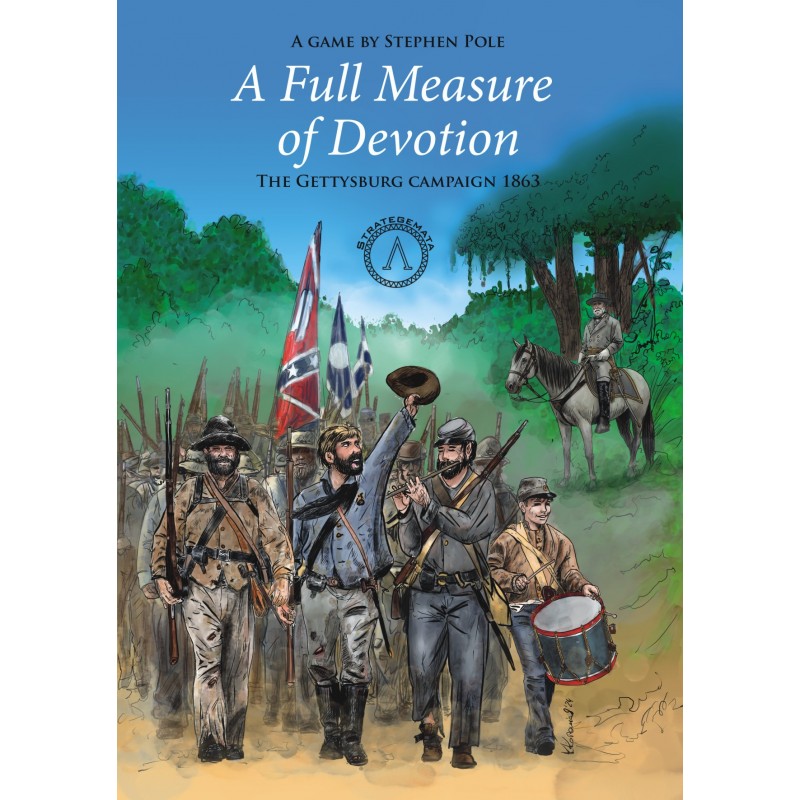











“Despite its significant military successes during the early years of the war, by 1863 the Confederacy was running short of basic foodstuffs and other supplies. Largely in an effort to alleviate this problem, Lee decided that his next move should be launch a large-scale raid into northern territory.”
Just click to open illustrated example of play
A Full Measure of Devotion
Designer: Stephen Pole
Publication year: 2025
“A Full Measure of Devotion” is a two-player wargame enabling players to recreate the “Gettysburg Campaign” of the Summer of 1863. One player controls the Confederate forces, the other, controls those of the Union. Forces are made up of “brigades” (although the term is used loosely) and each game turn represents about two days of actual time beginning in the second week of June 1863. Historically, the campaign ended with a decisive Union victory during a three-day battle near the town from which the campaign takes its name.
Central to the design is an enhanced and refined version of a mechanic which has been so well received in games such as “Fourteen Days in June” and “How the Union was Saved”. Only historical commanders are deployed on the game map. The actual composition of their forces is hidden by fog-of-war screens placed adjacent to the game map. The resulting uncertainty as to the enemy’s strength and intentions puts players in the shoes of their historical counterparts and provides them with ample scope for deception and surprise. This sense of realism is enhanced by the “initial order” and “delayed order” rules which introduce a time-lag between the issuing and an order and it being implemented, typical of an age when such communications relied upon messengers travelling by horse, often with only a vague notion as to the whereabouts of the unit for which the order was intended. As in the historical campaign, the weather, too, can throw a spanner in the works of the most meticulously planned maneuver.
The combat system is similar “Fourteen Days in June”, reflecting the leadership, number and type of troops, and the current state of the forces, engaged on each side, modified by a die roll. Players may have some discretion over the number of troops they commit to battle, which may enable them to disguise the size of a large body of troops if, for example, they suspect that the enemy is a small force on a reconnaissance mission.
Again, reflecting the historical campaign, the rules around logistics are asymmetrical. The Union forces relied upon a fairly conventional system of depots, often supplied by railways; whereas the Confederates essentially lived off the foodstuffs they were able to “liberate” by raiding Northern towns and farmsteads. Much of this booty was sent to the South to alleviate shortages in the Confederate heartlands.
Indeed, one of the Confederate victory conditions is based upon the amount of booty that they able to capture and send to the South. This requires a good deal of planning if they are to disperse their forces and send them through the most bountiful parts of Maryland and Pennsylvania whilst avoiding the main Union army. Alternatively, the Confederate player might elect to threaten principal northern cities – Baltimore, Harrisburg, Washington – with a view to forcing a decisive battle(s) on advantageous terms. For his/her part, the Union player also has to decide whether to take the initiative by seeking out and engaging the largest Confederate field army(ies) or whether to adopt a more defensive posture with the object of frustrating the Confederates by limiting the amount of death and destruction they are able to inflict upon the North.
The game allows players to explore the strategic options available to each side, to see if they can do better than their historical counterparts. Neither players’ task is easy. During testing victory usually went to the player who was able to guess their opponent’s strategy, whilst disguising his/her own, and capitalizing upon this by devising a plan with sufficient margin for error to accommodate enemy countermeasures and ill-fortune
Contents of the box:
- one 84x60 cm game map,
- 216 die-cut counters and markers of size 15x15 mm,
- 30 die-cut counters of size 15x30 mm,
- 21 wooden sleighs,
- two initial order sheets,
- two fog-of-war screens,
- four mountings for fog-of-war screens,
- an extended example of play,
- a sheet of sticky labels,
- one rule book,
- two 6-sided dice: one blue and one grey.
Wargame for two players from 12 years old upwards.
Playing time: 4 – 6 hours.
You might also like